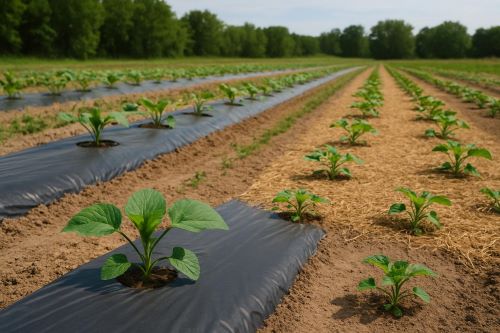


Mulching sheets are helping farmers achieve bigger and better harvests, especially as traditional methods fall short under climate variability.
At its core, a mulching sheet is a thin film spread over the soil, most commonly made of polyethylene or biodegradable material. It is a protective layer that stabilizes soil temperatures, locks in moisture, and suppresses weeds. While this might sound basic, the cumulative impact on soil health and crop performance is immense.
As mulching becomes a recognised solution, many growers are opting to buy mulching sheets through trusted online agri-platforms. These platforms offer multiple variants tailored for specific crops and climates, making the decision process far easier than relying on traditional supply chains.
One of the primary concerns in farming today is soil degradation. Over time, exposure to heavy rains, wind, and sun breaks down topsoil, leading to nutrient loss and reduced fertility. Mulching sheets play a critical role in protecting the soil structure by covering the surface and buffering it from the direct impact of weather elements.
The benefits are twofold. First, they prevent erosion by stabilising the top layer. Second, they reduce compaction caused by rain or foot traffic, allowing roots to penetrate deeper. The result? Healthier, more active soil ecosystems that support robust plant growth.
Good soil biology is the foundation of good farming. Wet, protected conditions are ideal for fungi, earthworms, and beneficial microbes. Mulching sheets provide the perfect environment for this subterranean life to thrive by regulating temperature and retaining moisture.
This results in a quantifiable rise in soil organic matter, a crucial fertility indicator, in long-term use scenarios. After three years of applying organic mulch with plastic sheets, a study in Maharashtra revealed a 23% improvement in soil organic carbon.
Farmers using mulching consistently report increased yields across a wide variety of crops. That’s because mulch creates an ideal growth environment—free of weed competition, evenly moist, and buffered against temperature extremes. This stability supports faster germination, stronger root systems, and better flowering.
In tomato farms across Karnataka, black mulch has led to an average 30% yield increase per acre. Farmers saw improved size and quality along with reduced water usage for fruit crops like watermelon and banana.
One of the most enduring dangers to agricultural output is weeds. They harbour pests, compete for nutrients, and frequently necessitate expensive solutions. Mulching sheets give farmers a natural way to control weeds without using chemicals.
Weeds lack the light required to thrive because mulch blocks sunlight from penetrating the soil. This lowers the need for herbicides and the frequency of hand weeding, which results in labour and financial savings.
“A farmer nurtures not just the crop, but the ground it grows from. A protected soil today is a fruitful harvest tomorrow.“
One of the standout features of mulching sheets is their adaptability. They are used effectively in arid zones to retain scarce water, in tropical zones to control humidity-related issues, and in colder regions to extend the growing season by warming the soil.
Mulching prevents quick water drainage in sandy soils. In clay-heavy soils, it helps reduce surface crusting and encourages better root growth. Whatever the setting, there’s a suitable mulching option.
Mulching works even better when integrated with other farming innovations:
These integrations form part of precision farming techniques that increase productivity per drop, per acre, and per rupee invested.
Choose based on crop duration, climate, and objective. Black mulch is versatile, while silver is good for pest-prone crops. Consider micron thickness and UV resistance.
Yes, biodegradable mulches made from plant-based materials are suitable for certified organic farms and decompose safely into the soil.
If not appropriately managed, plastic mulch can lead to waste buildup. Use reusable or biodegradable types and ensure correct disposal or reuse practices.
Depending on thickness and UV stability, it can last from one season to three years. Proper handling and storage increase lifespan.
